By Dr Simon Bradwell, Fan Manufacturers Association and ebm-papst A&NZ
Big cooling tasks need great technology, at the highest efficiency possible. This is especially important for industries that generally require a lot of power to run their operations, such as mining, manufacturing and construction.1
The industrial sector typically represents 30 to 40% of a country’s total energy consumption.2 This represents a huge potential for energy efficient equipment to help reduce overall carbon footprint as well as system efficiency. Using the available energy more efficiently contributes to cost savings and market competitiveness and is an effective countermeasure to uncertain energy futures. And while all resources consumed and waste produced by manufacturing affects the environment in some way, the focus of current work is on the efficient and effective utilization of resources, particularly energy resources.
How can this be achieved?
From a resources and electricity consumer’s point of view, there are three important drivers to introduce energy efficiency improvements:
- Rising energy prices
- New environment regulations putting a price on CO2
- Changing customer purchasing behavior with regards to green technology 3
The aforementioned drivers make energy efficiency an important pillar contributing to all three aspects (triple bottom line) that are considered in sustainable engineering frameworks.
What role do fans play in this?
The European Commission has taken the lead with respect to fans and power consumption. The EC has set an objective to reduce annual consumption of primary energy by 20% by 2020, estimates that an energy saving potential for the manufacturing sector of 25% could be realized by measures such as implementing energy efficient motors, fans and lightings. 4 This has already been taken on in Europe through MEPS and the ErP Directive. Of this, a significant proportion is fan and motor applications. Examples of integrated EC fan solutions show that 50-80% power savings are typical.
Fan efficiency explained
It is important to measure energy efficiency – but what is the definition of fan efficiency and what is a fan? A definition of a fan is shown in Figure 2 below.
Often fans are considered to be impellers only, but it is agreed that the components outlined in Figure 2 are all fundamental to the performance of the assembly and the whole system. Using motor shaft power, the normal nominal rating of shafted motors, as an input to an efficiency calculation does not take into account motor inefficiency, namely heat, electronic drive inefficiencies and mechanical transmission losses.
This definition of a fan from the international standard AS/NZ ISO12759; 2013 Fans – Efficiency and classification for fans, includes:
- Controls
- Drive/motor
- Air movement system
It should be noted that the Australian Building Codes has caused confusion in this area as they have only included shaft power in their definition of fan input power.
Fans and efficiency
Fan efficiency according to AS/NZ ISO 12759 is defined as the ratio of electrical power input before a controller, if used, to the air power output. For example, for a driven system that includes speed control:
ηed=Cc * Pu/Ped
Where:
ηed is overall efficiency for fans with drives
Cc is compensation factor to account for energy savings at part load
Pu is fan air power
Ped is drive/control electrical input power
In the standard there are several issues worthy of note:
Efficiency figures are defined at the best performance point. This follows the test protocol for fans in which fans are tested in the best performance arrangements such that comparisons between different products can be fairly made.
Efficiencies for the primary fans, eg. axial, centrifugal forward curve, centrifugal backward curve, mixed flow, crossflow, are all defined. Note – ventilation products are not “primary fans” and are not included.
A formula exists for uplift in efficiency figure if speed control is used.
In the development of AS/NZ ISO 12759, the ISO committee surveyed the fan market in order to obtain empirical data of fan efficiencies available in the market. From this data and the definition of fan efficiency, the standard then defines a minimum efficiency grade for FMEG (Fan Minimum Efficiency Grade) for fans with motor input powers greater than equal to 125W. Figure 3 shows the fan efficiency grades FEG for bare shafted fans.
FEG and FMEG are calculated from efficiency measurements and then define a gradation system by which regulators can define what is sold in a market and what is not.
Structural market changes
The standard and regulations have two important strategic effects.
As the product is now open to regulation, the manufacturers of fans and fan systems will be under technical scrutiny for the fans manufactured. This will mean that fan performance will need to be tested or proven by calculation. Manufacturers or contractors who are unable to do this will not be able to supply product into the market.
Speed control of fans has been identified as important in the reduction of power consumption and FEG uplifts are available if speed control is integral to the system.
Fans and speed control
Fan systems in air handling units, condensers or ventilation applications often use standard motors coupled to VSD/VFD drive systems.
Figure 4 below shows that if fans are reduced in speed by 25% then, according to fan laws, a corresponding 58% reduction in power occurs.
Many types of speed control for fans exist including capacitor control, voltage control and frequency control. However, many control methods do not obey fan laws as shown above, as the motor and VSD efficiencies reduce dramatically with torque and speed.5 In order to achieve typical fan law relationships, only permanent magnet motors (PMM) systems can be used. These are nominally known as EC (Electrically Commutated) fans. Note – PMM motors are now being brought into regulations controlling motors. PMM motors are likely to be defined as IE4 which is a grade higher than most AC motors.
New Developments
The EC efficiency data (note – an EC motor comprises a motor and a control system) is shown in Fig 5. This product complies with all existing international efficiency regulations. EC shows a minimal drop-off in efficiency in the useful range of >30% speed. AC motors, unlike ebm-papst EC motors, are designed to operate at a certain point on their performance curve which coincides with their peak efficiency.
Either side of this operating point, the efficiency can drop off considerably (see blue line in Fig 5). EC motors on the other hand have an almost flat efficiency curve which varies relatively little across the speed range (green line). This makes the EC fan much more flexible, in that we can use the same product to match the performance requirements of different applications while still benefitting from increased efficiency.
EC fans and motors : one principle, countless options
Companies such as ebm-papst manufacture intelligent, single or 3-phase, AC line powered EC drive motors that can attain full speed efficiency to 90 percent and maintain their high efficiency when operated at greatly reduced speeds.
EC motors are controllable and maintenance-free. A single motor design can drive several fan types, including axial impellers up to 1250mm, backward-curved radial impellers up to 710mm and forward-curved centrifugal wheels up to 450mm. The product line ranges up to 6kW.
Replacement of existing, inefficient AC technology is simple as EC fans use the same footprint and voltage input. Integrated electronics in EC mean that we don’t need a VSD/VFD, in turn reducing equipment cost and maintenance.
As electronics are an integral part of the fan, speed control is typically achieved using RS485 communication protocols such as MODBUS or BACnet. Other methods such as 0-10V or 4-20mA inputs are also typically available.
EC technology is efficient, quieter and more reliable, giving better performance and a lower whole life cost. Switching to EC technology has been shown to reduce fan electricity use by a minimum of 30% with typical savings of 50-75% achievable. With ever-increasing demand for energy efficient systems, when it comes to fan based products, there is a huge opportunity for EC technology to improve air movement systems and the bottom line.
- Figure 1: ebm-papst EC fans and motors come with in-built electronics
- Figure 2: Fan input power vs. output power as defined in AS/NZ ISO 12759: 2013 Fan Efficiency classification for fans.
- Figure 3: FEG for bare shaft fans
- Figure 4: Energy savings for EC fans in comparison to AC fans. The blue line shows the power input with continuous speed adjustment.
- Figure 5: Comparison of AC vs. EC fan efficiency curves
Endnotes
1 Duflou, JR et al 2012, Towards Energy and Resource Efficient Manufacturing: A Processes and Systems Approach, CIRP Annals – Manufacturing Technology, vol 61 no 2, pp. 587-609.
2 Eichhammer W 2004, Industrial Energy Efficiency, In: Encyclopedia of Energy, Elsevier, New York, pp. 383-393.
3 Bunse, K et al 2011, Integrating Energy Efficiency Performance in Production Management – Gap Analysis between Industrial Needs and Scientific Literature, Journal of Cleaner Production, vol. 19, no. 6-7, pp 667-679.
4 European Commission 2006, Action Plan for Energy Efficiency: Realising the Potential, Brussels http://ec.europa.eu/energy/action_plan_energy_efficiency/doc/com_2006_0545_en.pdf
5 Cf. Pierre Angers, Hydro Quebec, MEPSA Sydney 2009.



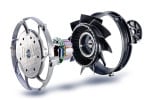

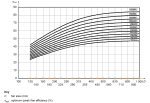
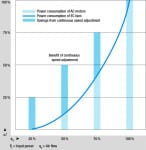
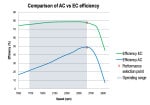





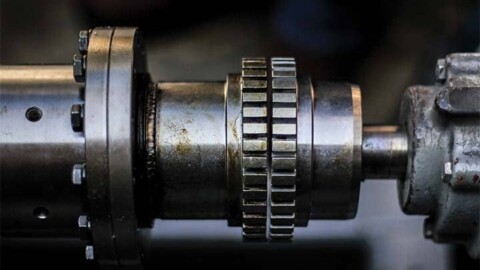











Comments are closed.